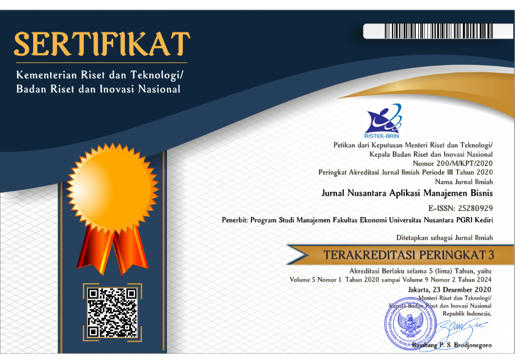The Customer Journey in Purchasing Counterfeit Fashion Among Generation Z
DOI:
https://doi.org/10.29407/nusamba.v10i1.22511Keywords:
customer journey, counterfeit products, generation Z, digital technologyAbstract
Research aim: The study aims to explore how digital technologies redefine the customer journey of generation Z, particularly on their experiences purchasing counterfeit fashion products.
Design/Method/Approach: This study employs the quantitative descriptive analysis technique. A survey was administered generation Z who have prior experience in purchasing counterfeit fashion items.
Research Finding: The findings reveal that online marketplace and social media play an important role in generation Z’s journey for counterfeit fashion. These two platforms not only increase awareness and appeal stages through advertisement and recommendation but also enable direct interaction and digital transactions.
Theoretical contribution/Originality: This study contributes to a relatively unexplored topic in developing countries like Indonesia, especially about customer journey and counterfeit purchases.
Practitioner/Policy implication: This study offers insights to policymakers and fashion industry stakeholders. An understanding of customer journey can help policymakers to advocate for policy regarding the ethics of counterfeit purchases. Additionally, the findings can assist fashion industry stakeholders in promoting the value of authentic products.
Research limitation: This study primarily focused on generation Z, hence limits its applicability to other demographic groups.
Downloads
References
[1] R. Sharma, V. Ahuja, S. Alavi, The Future Scope of Netnography and Social Network Analysis in the Field of Marketing, Journal of Internet Commerce 17 (2018) 26–45. https://doi.org/10.1080/15332861.2017.1423533.
[2] E.C. Brewer, T.L. Holmes, E. Patterson, Attribution in Omnichannel Retailing: A Preliminary Study in an Online-First Context, Society for Marketing Advances Proceedings (2021) 164–165. https://search.ebscohost.com/login.aspx?direct=true&db=bth&AN=157881754&site=ehost-live.
[3] K.N. Lemon, P.C. Verhoef, Understanding customer experience throughout the customer journey, J Mark 80 (2016) 69–96.
[4] M.M. Batra, Customer Experience: Trends, Challenges, and Managerial Issues, Journal of Competitiveness Studies 27 (2019) 138–151. https://search.ebscohost.com/login.aspx?direct=true&db=bth&AN=141992005&site=ehost-live.
[5] P.C. Verhoef, Omni-channel retailing: some reflections, Journal of Strategic Marketing 29 (2021) 608–616. https://doi.org/10.1080/0965254x.2021.1892163.
[6] P.C. Verhoef, K.N. Lemon, A. Parasuraman, A. Roggeveen, M. Tsiros, L.A. Schlesinger, Customer experience creation: Determinants, dynamics and management strategies, Journal of Retailing 85 (2009) 31–41.
[7] B. Baykal, Generational Differences in Omnichannel Experience: Rising New Segment: Gen Z, in: Managing Customer Experiences in an Omnichannel World: Melody of Online and Offline Environments in the Customer Journey, Emerald Publishing Limited, 2020.
[8] P. Kotler, W. Pfoertsch, U. Sponholz, H2H Marketing: The Genesis of Human-to-Human Marketing, Springer, 2021.
[9] R. Mishra, R.K. Singh, B. Koles, Consumer decision‐making in Omnichannel retailing: Literature review and future research agenda, Int J Consum Stud 45 (2021) 147–174.
[10] L. Wolf, M. Steul-Fischer, Factors of customers’ channel choice in an omnichannel environment: a systematic literature review, Management Review Quarterly (2022) 1–52.
[11] Datareportal, digital 2023: Indonesia, (2023). https://datareportal.com/reports/digital-2023-indonesia.
[12] G.K. Nathanael, D. Angeliawati, M. Muhadjir, The power of social media to influence people in Indonesia: case study of crazy rich scam and big data of election postponement, JPPI (Jurnal Penelitian Pendidikan Indonesia) 9 (2023) 439–448.
[13] S. Alavi, J. Habel, The human side of digital transformation in sales: review & future paths, Journal of Personal Selling & Sales Management 41 (2021) 83–86.
[14] P.S. Levy, S. Lemeshow, Sampling of populations: methods and applications, John Wiley & Sons, 2013.
Downloads
Published
Issue
Section
License
Copyright (c) 2025 Yenny Purwati, Arief Widodo

This work is licensed under a Creative Commons Attribution-ShareAlike 4.0 International License.
Authors who publish with this journal agree to the following terms:
- Copyright on any article is retained by the author(s).
- The author grants the journal, the right of first publication with the work simultaneously licensed under a Creative Commons Attribution License that allows others to share the work with an acknowledgment of the work’s authorship and initial publication in this journal.
- Authors are able to enter into separate, additional contractual arrangements for the non-exclusive distribution of the journal’s published version of the work (e.g., post it to an institutional repository or publish it in a book), with an acknowledgment of its initial publication in this journal.
- Authors are permitted and encouraged to post their work online (e.g., in institutional repositories or on their website) prior to and during the submission process, as it can lead to productive exchanges, as well as earlier and greater citation of published work.
- The article and any associated published material is distributed under the Creative Commons Attribution-ShareAlike 4.0 International License












